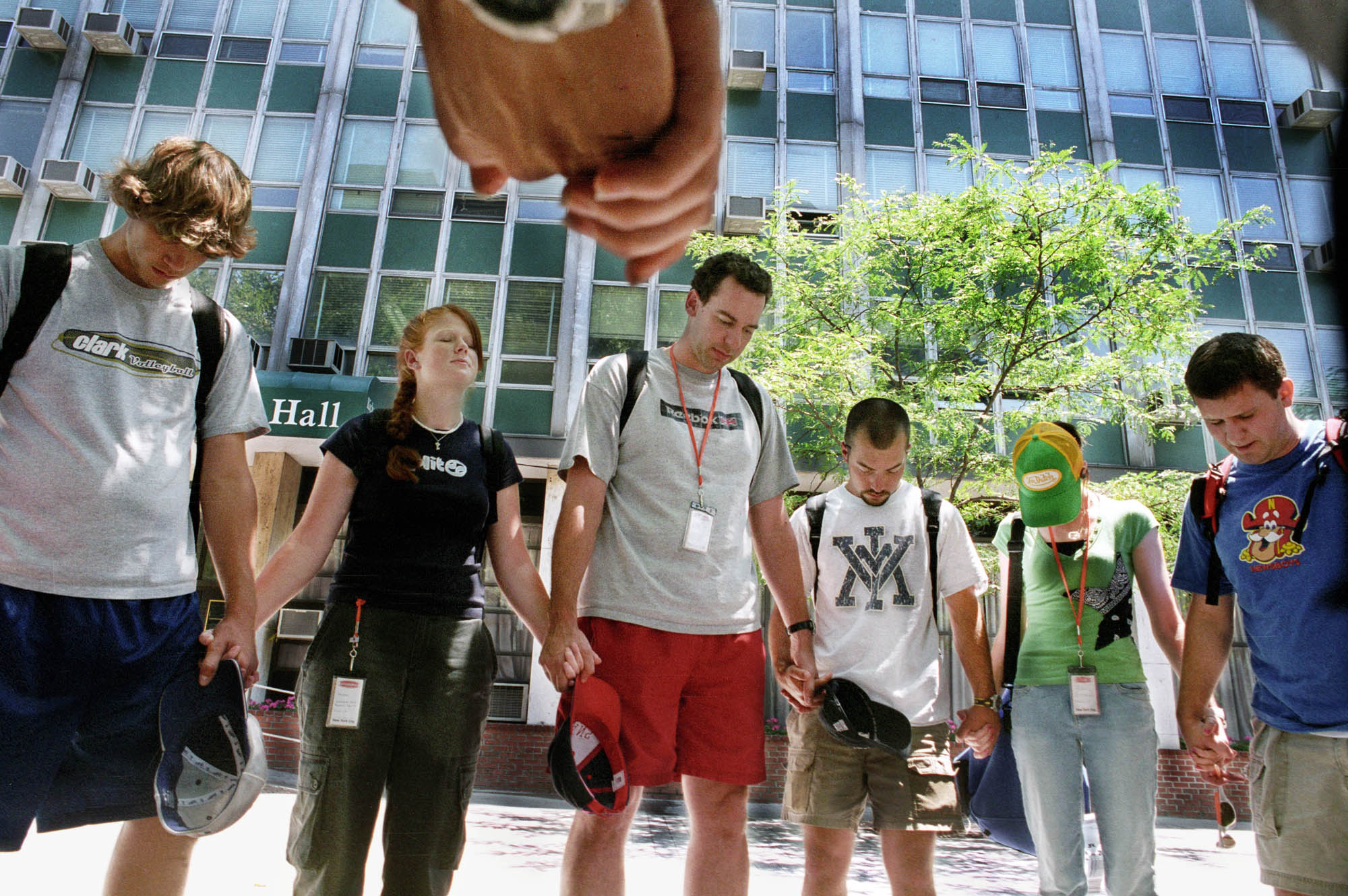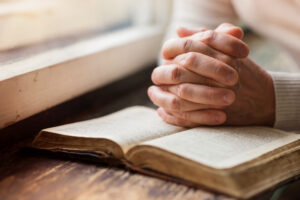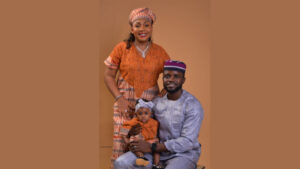
NEW YORK (BP)–At 8:45 a.m. on Tuesday, Sept. 11, 2001, Tom Fortner sat down for a quick breakfast. Only five miles from where Fortner blessed his meal, a Boeing 767 commercial airliner navigated by terrorists slammed into the North Tower of the World Trade Center.
Too far from the twin towers to hear the crash, a co-worker told Fortner and others about the mysterious crash. They then looked out the windows and turned their eyes to the largest building in the skyline to watch as the tragic events of the next few minutes unfolded.
In those minutes Fortner got his first opportunity to tell a New Yorker about Jesus. Though she had no interest in making a decision at that moment, Fortner was undeterred.
“I plant the seeds and it’s God’s job to make them grow,” said the bivocational pastor and computer network engineer.
That day — and in the days following — a variety of New Yorkers listened as Fortner told them about Jesus. Still no Gospel seeds germinated that day.
As Fortner walked back that night from a sparsely attended prayer meeting, he prayed as he walked. New Yorkers showed unprecedented openness as they began to recognize their vulnerability. Yet Fortner, who would soon be returning to his home in Dallas, felt small and helpless to meet the city’s staggering spiritual needs.
“Send someone else to pick up where I left off,” Fortner prayed.
God has spent the last decade answering that prayer. They’ve come from many states and denominations to the universally acclaimed capital of the world to share Christ and start evangelistic churches.
According to a study by the Values Research Institute and reported on the new www.nycreligion.info Web magazine covering religion in the city, 40 percent of Manhattan evangelical churches started after 2000. That’s about 80 churches. During a two-month period in 2009, at least one new Manhattan church started every Sunday.
In an era when most churches are experiencing attendance declines and closings, New York City has been an unheralded aberration. In fact the seeds of Fortner’s answered prayer were already in the city that Friday, Sept. 14, when the frazzled pastor/engineer drove his rental car back to Texas.
A GOSPEL ECOSYSTEM
Two days after Fortner left, on the first Sunday after the 9/11 attacks, Southern Baptist church planter Nelson Searcy held two memorial services in a Manhattan hotel. Ninety people showed up. He held prayer services once a month for the next few months.
In the spring, Searcy teamed up with another young church planter, Kerrick Thomas, who had been planning a new church in the East Village. The two would combine their efforts and start one church with multiple campuses. Nearly a decade after The Journey’s official launch on Easter 2002, the church has 1,000 people in attendance each weekend on four campuses around the city (and another 250 people in its Boca Raton, Fla., campus, launched by Searcy in February 2011).
Look deeper and it’s clear that God started answering Fortner’s prayer long before 9/11, more than a decade earlier in fact. For example, in his 2002 book “The Power of a City at Prayer,” Mac Pier documents a prayer movement in the years leading up to 9/11. Tim Keller had arrived in New York City in 1989 and founded Redeemer Presbyterian Church, which has started 75 churches in the city in the past two decades. And the number of evangelical Christians had already started climbing before 9/11. According to the Values Research Institute, the percentage of people in center-city Manhattan who identify themselves as evangelicals has more than tripled (from less than 1 percent to 3 percent) since 1990.
“When you have a concentrated church planting focus, you’re able to push back darkness,” said Aaron Coe, who started Gallery Church in Manhattan in 2006 and now serves as a vice president for the North American Mission Board. “The foundation for that has to be laid. Tim Keller calls it the Gospel ecosystem. The ecosystem was brewing way before the church planting movement started.”
A GOSPEL RESPONSE TO TRAGEDY
So was 9/11 the catalyst for the church planting boom in Manhattan?
Yes and no, say Southern Baptists in the city today. Most say that 9/11 brought New Yorkers back to the faith and traditions of their past. For most, that wasn’t born-again Christianity.
In fact, despite now being one of the largest churches in Manhattan, Thomas said The Journey’s growth was slow in the months and years directly following the tragedy. The church had 110 people in attendance for its launch, but the number dropped in half the next Sunday and to 35 by the summer. The church baptized just one person during 2002.
“The first few months I remember struggling, wondering if anyone would show up,” Thomas said.
Slowly over the next few years, people did show up — first 100, then 300, then 500. In its first nine years, the church baptized 1,000 new believers.
As The Journey grew, evangelicals, including Southern Baptists, began looking for ways they could demonstrate and verbally share the Gospel in the city. While 9/11 may not have changed the spiritual temperature of New Yorkers, it did focus the attention of the evangelical world on the city.
In 2003, NAMB named New York City a Strategic Focus City, a four-year emphasis that brought church planters and much-needed resources to Southern Baptists in the city. During the “New Hope New York” campaign, Southern Baptists started around 45 churches.
“When you see how evangelical adherence has grown in the city and you see how 40 percent of the churches in Manhattan have been started since [2000], we can thank God that Southern Baptists had a part in that,” said Steve Allen, NAMB’s lead catalyst for the New York City Tri-State Church Planting Team. “That’s satisfying and exciting.”
Churches across the convention sent volunteers to the city to help with the church plants that were starting. Shades Mountain Baptist Church in Birmingham, Ala., for example, got involved in New York City near the beginning of New Hope New York. Volunteers from the church have participated in everything from an evangelistic tailgate party at a Rutgers football game to service projects and training for churches in special needs ministries. Shades Mountain has remained consistently involved in church planting in New York City for most of the past decade.
Danny Wood, Shades Mountain’s pastor, is turning the church’s involvement into a broader effort to engage Southern Baptists in church planting in New York City. Wood serves as the chairman for the Send North America New York City Coalition, part of NAMB’s Send North America church planting strategy.
“We’re all part of this incredible Southern Baptist Convention,” Wood said as he urged other Southern Baptist pastors to involve their churches in the New York City work. “Knowing we’ve been blessed with a number of resources in our churches, we need to go to those other areas and help them in the resource department. Our role [as established churches elsewhere] is to get boots on the ground to help some of these churches get started.”
WORK TO BE DONE
Despite the church planting boom over the past decade in New York City, particularly in the Manhattan city center, the work is far from finished. While going from 1 to 3 percent in evangelical strength means hundreds of thousands of new believers, the city still is close to the official definition of an unreached people group, making the Big Apple and the 20 million people in the metro area a mission field of massive proportions.
The spiritual needs loom large particularly among non-English speakers. NAMB missionary Chris Clayman, whose book “EthNYcity” chronicles the culture and spiritual needs of the city’s various ethnicities, points particularly to New York’s large Arab Muslim population. Clayman notes that it has been two decades since a church planter has come to New York City to start churches among Arab Muslims, even as church planting and the overall evangelical presence have increased.
In fact, Clayman suggests that a Muslim from Mali has more access to the Gospel in his own language back home in his native country than in New York City. In all of New York City, Clayman said, there are only two churches of mostly Muslim-background Christians.
“For many American Christians, [9/11] provoked more fear than love when it comes to working with Muslims,” Clayman said. “But fear never really reaches anyone. From our perspective, that has to change. We have to be motivated by love.”
It has been a decade since Fortner prayed his prayer in a brittle and broken New York. In those 10 years Southern Baptist church planters and volunteers, along with other evangelicals, have served as pioneers in loving the city and laying the Gospel groundwork for years to come.
Now, as Southern Baptists look toward a new concentrated focus on church planting through Send North America, Wood and others are urging churches to join them in reaching out to this city.
“It gives you both hope and excitement to know that you can already see a move of God,” Wood said. “When you see the additional churches planted in the city, there has to be fruit. That should encourage us to go and plant even more churches in the city.”
–30–
Tobin Perry is online editor for On Mission at the North American Mission Board. To find out more about the Send North America strategy for New York, visit www.namb.net.
















